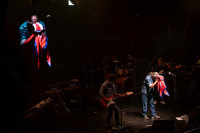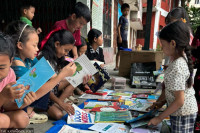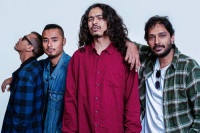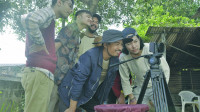Entertainment
Picking 7
The Kathmandu University’s School of Art and Design’s BFA show was brilliant, giving us a glimpse of Nepal’s future trajectory in art and design
Kurchi Dasgupta
This week I was lucky to catch the Kathmandu University’s School of Art and Design’s BFA show at Nepal Art Council. I consider myself lucky because in a show like this you come across trends and energy that shows by established and practicing artists with a settled oeuvre might otherwise lack.
There were 22 budding practitioners in artmaking and design, of whom, unlike my usual self, I will give a final countdown of seven. To begin with, the level of proficiency in painting was quite astounding. Starting with Amrit B Karki’s efficiently done portraits, through Minod Bhaila’s exquisite drawings of currency notes with economic-political messages, through Saroj Maharajan’s pastiche combining traditional ‘paubha’ iconography with self-portraiture, and Manju Sunuwar’s inspired but weakly executed tableau of memories, I especially liked the hybrid work of Sushank Kalapremi Shrestha. His finely executed sci-fi drawing interventions against digital photographs were good enough to invite a tactile reassurance on my part. Hishila Maharjan’s exemplary idea of mixing up self portraits in a weave was inspiring too, but her drawing needs improvement. Ximi Wang’s inspired Monroe series had one good piece (after Batman’s Joker), and the rest forced. But it was Bharat Rai’s rather innocuous series of pissing dogs that were immersive and fluid enough to keep me thinking for days after.
Perhaps the most surprising of all was Bibek Thapa’s perfectly turned out carpet work—it was a joy to experience because of the fine craftsmanship and aesthetic vision. More so because it comes from a ‘male’ in an otherwise derogative ‘female’ led industry cum art. Of the videos, Parish Shakya’s time lapse work on growing saplings was more interesting compared to Rahul Thapa’s ‘everyday images of Kathmandu’ but they both need to embody the experience of video more, explore its textures and rhythm more, to arrive at better results. Yahju Manandhar’s more than a dozen boxes allowing us keyholes into his world were exciting for the labour he has taken over the hard craft, and less for the image making, which were fine nonetheless. Of the installations, Kshitij Maharjan’s endearing waste wood, rhythmic installation was very refreshing. As was Shyam Prajapati’s painstakingly executed series of traditional artefacts in clay as a comment on contemporary consumerism—he has the sure vision of a perfected neoliberal artist. Santosh Jarga Magar’s ambitious installation of 12 manufactured hands working on a cool fibonacci sequence for clapping somehow fell flat when experienced. Kunjan Tamang’s exquisite metal filigree and graphic canvas works occupied a lot of space and light but did not deliver as much. Sameer Tamraker’s lone photographic journey was executed well, but presented better and unforeseenly when in a basket. The deign section impressed me with Prajwal Manandhar’s expansive ‘Station 9’, which was indeed surprising for its meticulous execution at a student-level. Anushri Lama’s pop-up book was a joy to go through as well.
I missed sound works. Am sure KU will look into that in future. It was a brilliant show as a whole, giving us glimpse of Nepal’s future trajectory in art and design.
My best seven in descending order: Bibek Thapa, Bharat Rai, Amrit Karki, Prajwal Manandhar, Sushank Kalapremi Shrestha, Kshitij Maharjan, Shyam Prajapati, Parish Shakya. Though I liked them all. Nepal has indeed a bright future if artists and designers of this calibre are produced yearly.
Dasgupta is an artist and writer based in Kathmandu




 22.78°C Kathmandu
22.78°C Kathmandu










